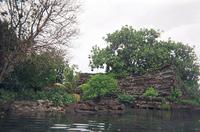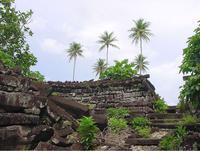You are in: Oceania -> Micronesia, Federal States of -> Nan Madol: Ceremonia... , and traditional search or Image Gallery will yield results of this site only
Nan Madol: Ceremonial Centre of Eastern Micronesia
| Site number: | 1503 |
|
| Type of site: | Heritage in danger | |
| Date of Inscription: | 2016 | |
| Location: | Oceania,Micronesia, Pohnpei, Nan Madol | |
Up to 75 images are shown here. Click on each for more details or on Image Gallery for more images.
| Description: | Nan Madol is a series of more than 100 islets off the south-east coast of Pohnpei that were constructed with walls of basalt and coral boulders. These islets harbour the remains of stone palaces, temples, tombs and residential domains built between 1200 and 1500 CE. These ruins represent the ceremonial centre of the Saudeleur dynasty, a vibrant period in Pacific Island culture. The huge scale of the edifices, their technical sophistication and the concentration of megalithic structures bear testimony to complex social and religious practices of the island societies of the period. The site was also inscribed on the List of World Heritage in Danger due to threats, notably the siltation of waterways that is contributing to the unchecked growth of mangroves and undermining existing edifices. --WHMNet's description is from WHC Site, where additional information is available. | |
| Nan Madol is a ruined city adjacent to the eastern shore of the island of Pohnpei that was the capital of the Saudeleur Dynasty until about 1628. It is in the present day Madolenihmw district of Pohnpei state, in the Federated States of Micronesia in the western Pacific Ocean. The city, constructed in a lagoon, consists of a series of small artificial islands linked by a network of canals. The site core with its stone walls encloses an area approximately 1.5 km long by 0.5 km wide and it contains nearly 100 artificial islets—stone and coral fill platforms—bordered by tidal canals. The name Nan Madol means "spaces between" and is a reference to the canals that crisscross the ruins. The original name was Soun Nan-leng (Reef of Heaven), according to Gene Ashby in his book Pohnpei, An Island Argosy. It is often called the "Venice of the Pacific". --Wikipedia. Text is available under the Creative Commons Attribution-ShareAlike License. | ||
| Source: | http://whc.unesco.org/en/list/1503 | |
| Source2: | Wikipedia (http://wikipedia.com) | |
| Reference: | 1. UNESCO World Heritage Center (http://whc.unesco.org/en/list/1503). 2. Wikipedia. | |






